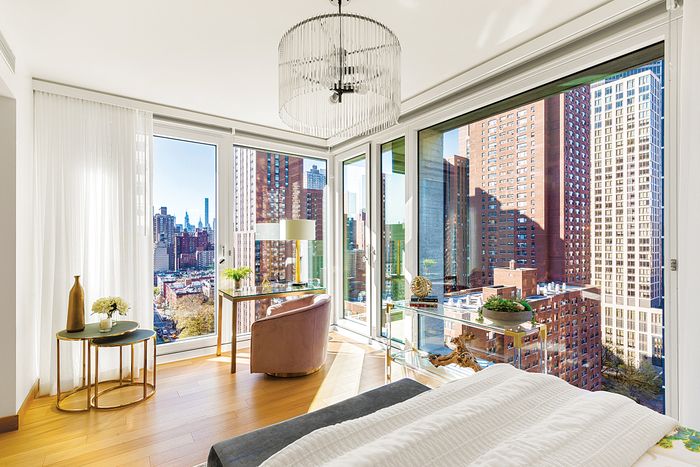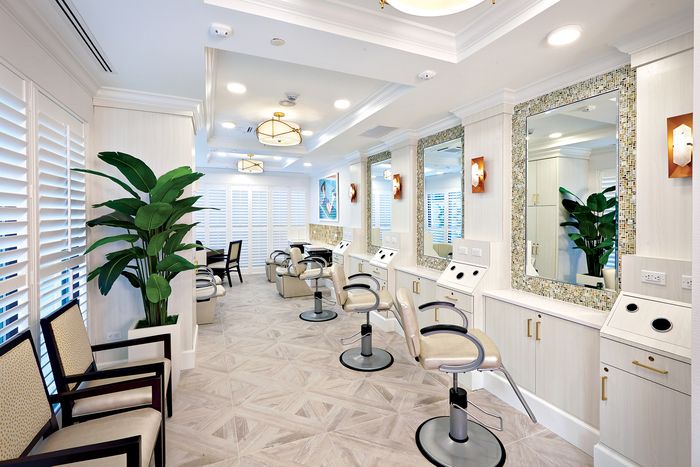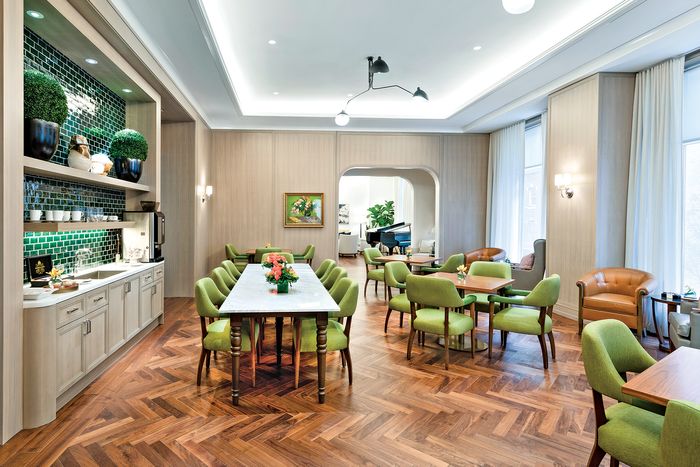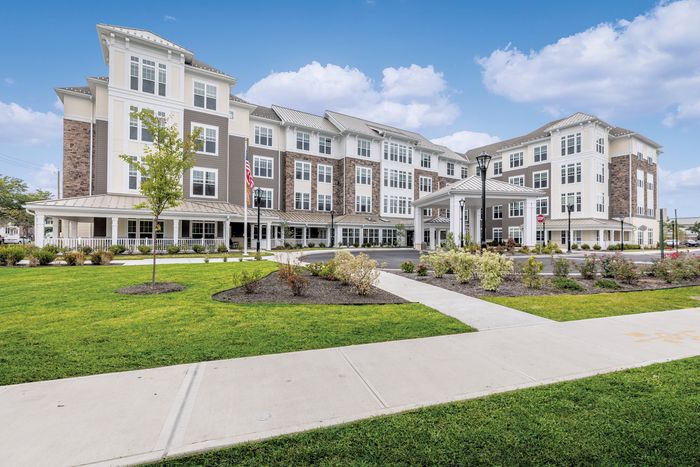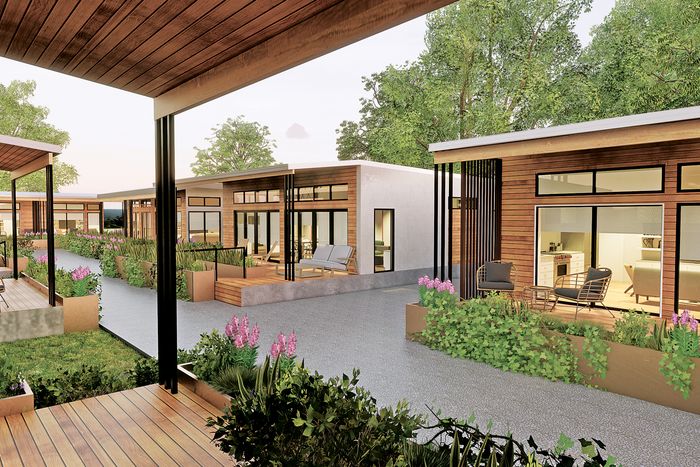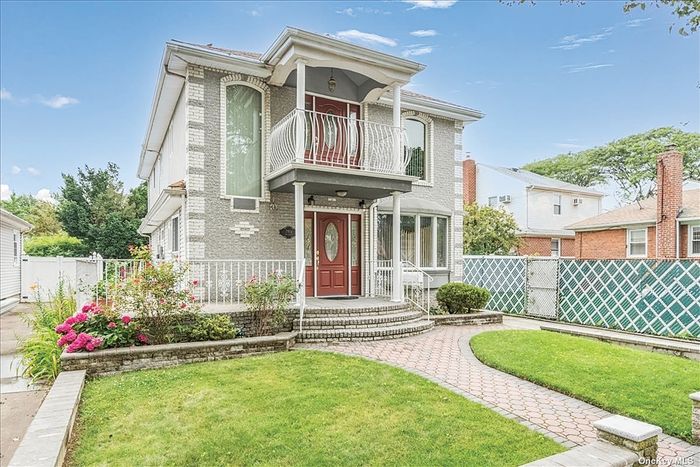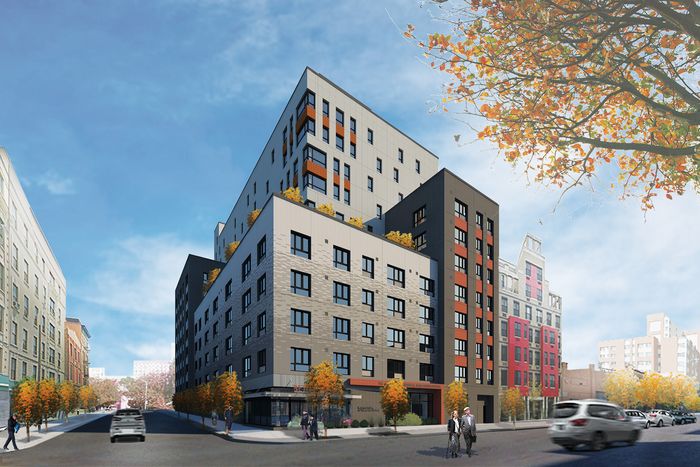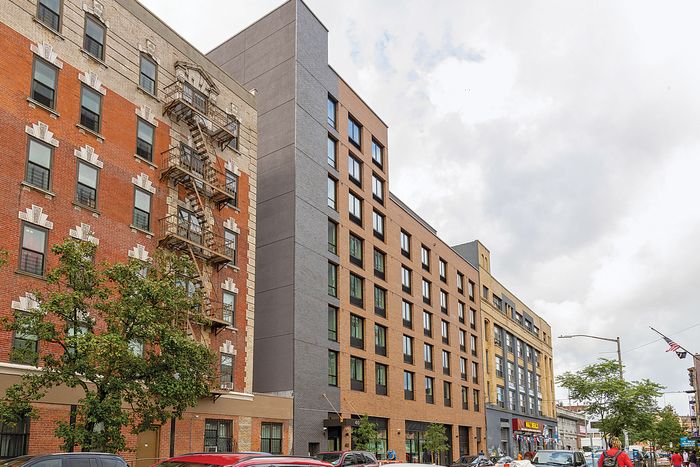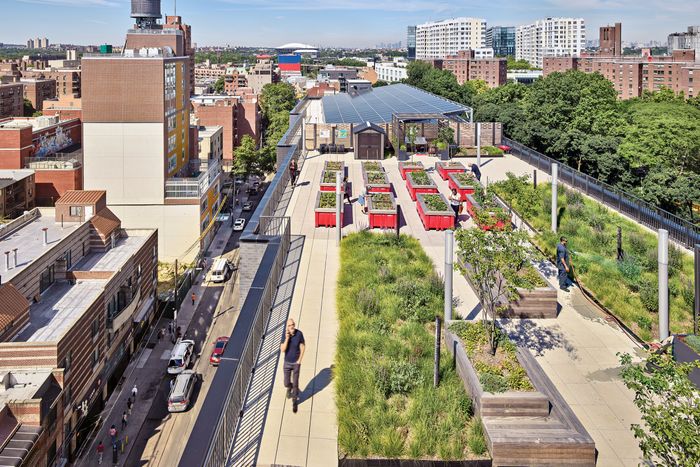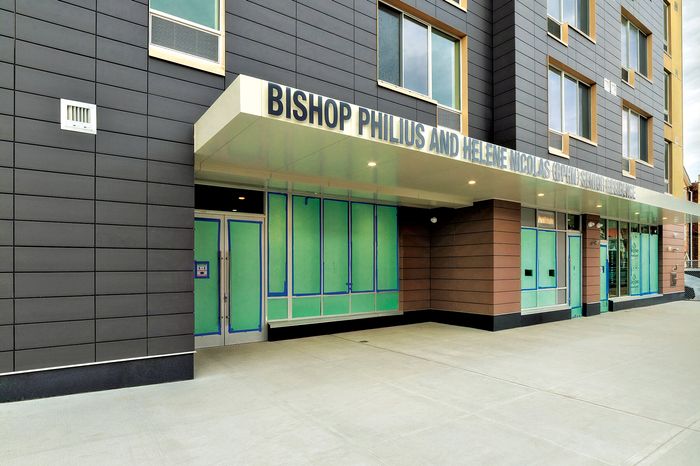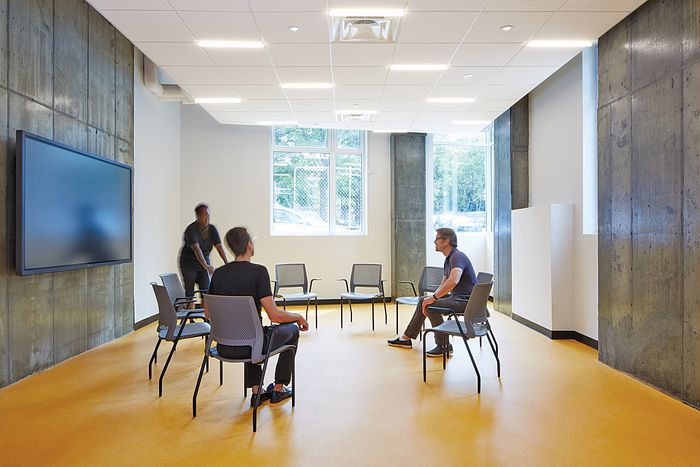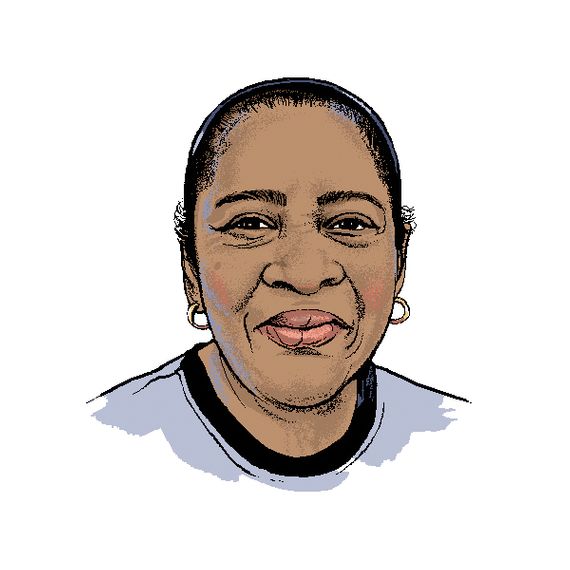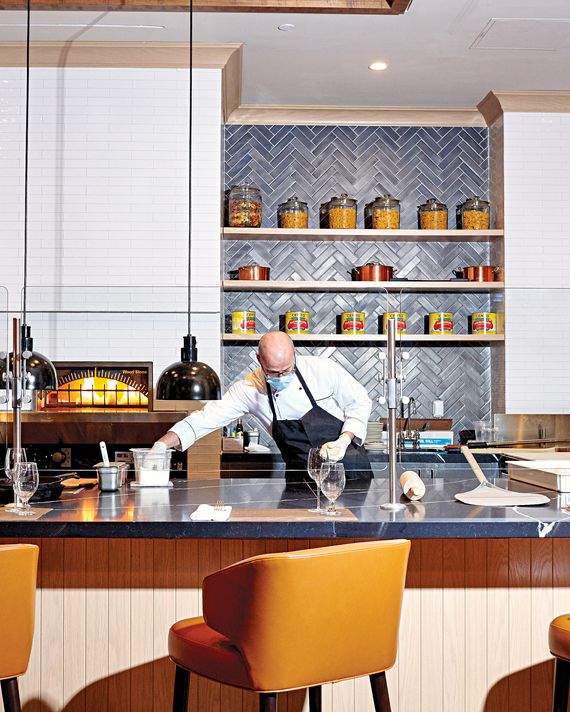
In this article
The city has grown old. More specifically, 1.2 million New Yorkers are now over the age of 65, a senior population that has gone up by nearly 30 percent in the past decade. This is an increasingly diverse group with a wide array of needs and preferences when it comes to where to live: About half of seniors speak one of 90 languages other than English at home, a quarter have advanced degrees, and thousands are part of the LGBTQ community.
Fortunately, new housing options have begun to proliferate over the past few years. On one hand, a plethora of very high-end assisted-living apartment buildings have emerged to serve the wealthiest of aging boomers. These places tend to eschew beige meals and snoozy game nights for page-long seasonal menus, classes led by Columbia professors, and marble-and-teak spas. (All of this comes at a commensurately steep price — independent studios at the Watermark at Brooklyn Heights start at $5,495 per month, while memory-care and assisted-living options balloon to more than $20,000 per month.)
Choices have multiplied in the affordable housing–scape, too. Hundreds of new units were built every year by the de Blasio administration. These are difficult spots to win — a 2016 study found that waiting-list times for low-income senior housing are, on average, a startling seven years. And though de Blasio promised $500 million to build low-income housing for seniors in 2018, he fell short (though the city did help to finance 12,900 new homes during his tenure). Much like the citywide fight for affordable housing, the senior-housing crisis is up against notoriously long permit processes, a lack of vacant land and building subsidies, and community opposition (the development saga of the 123-unit building planned for the site of the Elizabeth Street Garden, for instance, has dragged on for ten years). Often, by the time units get built, demand has only grown: An 88-unit building in East Flatbush that had been in the works for decades saw upwards of 10,000 applicants.
But the spaces that have opened recently, and those that are in progress, are greener and more accessible, per updates to the city’s development guidelines, with new, highly specialized social services and amenities. In 2020, a first-of-its-kind LGBTQ-friendly community opened in Fort Greene; that same year, Curtis + Ginsberg Architects, a firm that tends to focus on sustainable affordable housing, opened a tower that will reserve a portion of its apartments for formerly incarcerated seniors. Big-name architects are getting into the space as well — construction recently started on the Atrium at Sumner in Bed-Stuy, Daniel Libeskind’s first ground-up building in New York, composed entirely of affordable senior housing.
The Highest-End Homes
.
The Watermark at Brooklyn Heights
21 Clark St., Brooklyn Heights
Opened: October 2020
Size: 275 apartments
Care and cost: A onetime membership fee of $50,000 for independent living or $20,000 for assisted living and memory care, plus monthly fees ranging from $5,495 for an independent-living studio to $19,995 for an assisted-living two-bedroom. Memory-care units cost $8,995 to $13,495.
Design and amenities: Set in a palazzolike 16-story building that was once the Leverich Towers Hotel (designed in 1928 by the architects of the Saks Fifth Avenue store), this amenity-packed senior residence is what convinced Bob and Marie Secor, 83 and 82, to downsize from an 11-room home in Pennsylvania to their first-ever one-bedroom apartment. “We don’t need the extra rooms. We have them downstairs,” says Bob, pointing to the library–slash–wine bar and indoor heated pool (both of which are resident favorites, he says). At the wellness-resort-esque community, “integrative well-being” goes beyond massages and acupuncture (though both are offered on-site) to include intellectual stimulation, such as workshops taught by Brooklyn Conservatory of Music faculty and Hollywood movie directors. Local excursions, like a trip to Lightscape at the Brooklyn Botanic Garden, draw a big crowd, according to the Secors. “We used to just come in for the day to go to the MoMA. Now we can see a show and watch the sunset over Manhattan from our window,” says Marie.
Dining: The hotel’s former grand ballroom is now a 140-seat main dining room decorated with chandeliers and a small clock tower; daily meals are served on specialty china fabricated to look like pieces from the original Leverich Towers Hotel. The menu options include farro salad with honey-date chicken. Marie especially appreciates that the chef seeks input. (“He comes out every night after dinner to ask us what we’d like to see next time.”)
.
Inspir Carnegie Hill
1802 Second Ave.
Opened: March 2021
Size: 215 apartments, seven penthouses
Care and cost: Studios, one-bedrooms, and two-bedrooms are available on the assisted, enhanced (skilled nursing), and memory-care levels starting at $13,500 per month plus extra for medical care. Penthouses start at $17,000 per month.
Design and amenities: George Smith furniture and Seguso chandeliers fill the lobby of this Upper East Side retirement home. The belowground fitness center features a saltwater pool and meditation classes led by Namaste, a Goop-approved wellness concierge. On the second floor is one of the building’s many terrace gardens — the site of an apparently well-attended horticultural-therapy program — plus an art studio that will include Jewish Museum–led classes in non-COVID times. Apartments, which are grouped by levels of care, have Calacatta gold marble bathrooms.
Dining: An espresso bar and lounge off the main lobby leads into a multiroom formal dining area where residents order adjective-themed dishes, like “Indulgent” for challah custard French toast or “Valiant” for filet mignon. Seventeen stories up, a glass-walled floor is divided into a fireside cocktail lounge and a casual bistro that serves smoothies made with hemp oil.
.
The Bristal at York Avenue
1622 York Ave.
Opens: February 2022
Size: 132 apartments
Care and cost: Studios range from $12,800 to $20,150 per month for assisted living and memory care, respectively, and an assisted-living one-bedroom costs $24,000 per month. Independent living is available for the same price.
Design and amenities: Each floor of the Bristal — which, incidentally, sits only a few blocks southeast from Inspir — has just 11 units plus a fireside living room and glass-enclosed terrace — features that appealed to Madelyn Hochstein, 80, who compares the residence to a “cozy hotel.” The lifelong New Yorker is pleased that she’ll be able to take a daily walk in Carl Schurz Park. “Eighty-sixth and York is fabulous for buses to Lincoln Center and Carnegie Hall,” she says. A Mercedes-Benz bus, in fact, will be parked in front of the Bristal to drive residents around, and cultural events, like Juilliard performances and Columbia-professor-led lectures, will come to the residence too.
Dining: Mediterranean fare is one focal point of the Bristal’s lobby dining room, which Hochstein says will be a “nutrition upgrade” from her usual takeout dinner. Themed meals, like a candlelit Valentine’s Day dinner, are scheduled. On the 14th floor, where a glass-walled bar-bistro will serve wine and cheese, there is a dining room. Every residential floor (excluding memory care) has a dining area equipped with induction burners where chefs will cook, say, grilled shrimp.
.
Sunrise at East 56th
139 E. 56th St.
Opened: December 2021
Size: 151 apartments
Care and cost: Studios and one-bedrooms range from $13,000 to $21,000 per month for assisted living and memory care, respectively.
Design and amenities: Champalimaud Design, the studio behind the Carlyle hotel, outfitted the senior-living project with ergonomic furniture and two grand pianos. Pamela Artino* moved her mother, a 77-year-old with Alzheimer’s, into East 56th after dealing with insufficient care at another senior-living facility. “I now trust my mother is being taken care of,” Artino says, recalling how a team member sat outside her mother’s door all night when she first moved in — an “anxiety inducing” time when Artino called and texted East 56th staff “over a dozen times.” Now that she’s settled in, Artino says her mother, who’s lived on the Upper East Side since the ’60s, is enjoying activities like in-house Juilliard and Carnegie Hall performances. She’s try ing new things, too, including a MoMA-led painting class and physical-therapy sessions, which had become harder for her to do alone.
Dining: There is a bistro with grab-and-go options, like pastries and sandwiches from Balthazar Bakery, and a formal dining room. On the menu: yogurt bowls with Hudson Valley honey and a Reuben sandwich with Katz’s Deli corned beef. Memory care has an in-unit dining room that offers the same menu, though Artino’s mother prefers to order just bacon and eggs (which the chef is willing to cook up).
.
Sunrise of New Dorp
470 New Dorp Ln., East Shore
Opens: 2022
Size: 95 apartments
Care and cost: Studios, one-bedrooms, and two-bedrooms range from $125 per day for assisted living to $216 per day for memory care. Medication and additional care cost extra.
Design and amenities: New Dorp, a suburban-feeling neighborhood on the East Shore of Staten Island, will be Sunrise’s fifth location in the city (the others are in Mill Basin, Sheepshead Bay, on the Upper East Side, and elsewhere in Staten Island). Across the street is New Dorp High School, which the residence will partner with for intergenerational programs, such as letter writing and woodworking. The four-story Sunrise Mansion will have a stately lobby staircase and plant-filled patio.
Dining: A fireside bistro, plus New Dorp’s main dining room, where chef Daisy Martinez — a Food Network and PBS cooking-show host who’s written three cookbooks — will serve a Latin-inspired menu.
In the Works: A — Dare We Say ‘Cool’? — Community Coming to the Hudson Valley
Next year, Chris Krager, Zach Hollander, and AJ Viola will open the first of their Kindred Uncommon communities in Austin, Texas. The idea behind Kindred Uncommon, says Viola, is to create enclaves for “forward-thinking” older adults (and some young people) near small cities with “local yoga studios and coffee shops” — a sort of Florida retirement community for those who aren’t keen on living in a Florida retirement community. At the first location, residents will move into glass-and-wood apartments with wide porches (“So you can sit and talk to your neighbors,” says Hollander) and use shared calendars to plan communal dinners and concerts (no “cruise-ship-like programming directors needed,” he says). After Austin, they plan to break ground in the Hudson Valley — “somewhere with a view of the Catskills and a short drive to an art gallery,” says Krager.
In the Works: A Desi-Specific Senior House Soon to Open in Queens
When Dr. Vasundhara Kalasapudi’s father was diagnosed with dementia, she thought about moving him from India to Queens, but she couldn’t find any culturally sensitive care. “Everyone told me they don’t serve curry or speak Telugu,” she says. Facing a dearth of South Asian senior-care services, the doctor, a geriatric psychiatrist, helped found India Home in 2007, which brings Desi-specific services to senior centers across Queens that serve South Asian elders, such as linguistically adapted tech classes and iftar meals. This year, the nonprofit plans to open its first-ever physical space: a single-family home in Floral Park with room for up to six seniors. The below-market cost of rent will include transportation to local religious sites, shared vegetarian meals, and sessions with Gujarati-speaking case managers. India Home has plans to eventually open a Bengali-speaking co-living space in Jamaica.
5 Newly Built Affordable
.
1080 Washington
1080 Washington Ave., Morrisania
Opened: October 2021
Curtis + Ginsberg Architects, known for projects like NYCHA Coney Island, finished construction on this affordable senior building last year in the Morrisania area of the Bronx. On the site of a former church, the 154-bed building now has a sunroom with hydroponic planting beds, a 3,750-square-foot community space, an exercise room, and a garden. The building is also well insulated, using principles from Curtis + Ginsberg’s Passive House projects. “Basically, you make the building into a thermos so it’s extremely well insulated, which reduces energy consumption by 50 to 70 percent,” says partner Mark Ginsberg. Thirty-seven percent of the units are reserved for seniors who are formerly incarcerated, and the Fortune Society — which focuses on reentry — is operating a social-services space on the ground floor.
.
Debevoise Senior Housing
40 Debevoise St., Williamsburg
Opened: November 2021
Offering affordable senior housing in one of the city’s most expensive neighborhoods, this 64-unit building comes with local touches like a bike-storage room (which developers hope will “promote alternative transportation options”) and has views of Manhattan. There’s a social-services center in the basement, where Johnny Bell, 66, has weekly meetings with his caseworker, who is helping him make the move from a shelter into a studio apartment. “We got all the supplies I need from the supermarket around the corner. It’s a very accessible area; whenever I Google places to go, they’re always in walking distance,” he says.
.
One Flushing
133-45 41st Ave., Flushing
Opened: February 2019
An intergenerational apartment building and community complex near Flushing’s bustling Main Street. There’s a Korean dessert shop, an urgent-care facility, and a community center on the lower levels. The ten stories also include a laundry room, gym, and rooftop farm. Sixty-six units have been set aside for low-income seniors. Half of all tenants are from Flushing and other nearby Queens neighborhoods.
.
Bishop Philius and Helene Nicolas Senior Residence
1488 New York Ave., Flatbush
Opened: April 2021
This 88-unit senior residence is named for the founders of the Evangelical Crusade Christian Church, a nearby Haitian religious community that originally owned the property and advocated for the project for decades. In 2019, the church and Brisa Builders broke ground on the residence, which opened this past spring. BPHN meets sustainability standards and has a live-in super. The apartments have stainless-steel appliances and a video buzzer. Offices for Selfhelp, a senior-support nonprofit, are on the second floor, and there’s a private outdoor terrace and a community room with a TV. The church plans to open a senior center next door, where it will run yoga programs and host food pantries.
.
Stonewall House
112 St. Edwards St., Fort Greene
Opened: January 2020
New York’s first, and the nation’s largest, LGBTQ-friendly affordable-housing development for elders. Bill Meehan, 78, moved into the 145-unit building at the onset of the pandemic but found community in a Facebook group where residents offer to grocery shop for one another and a tenants association, which he started with neighbors to secure a nearby bus stop. When the building’s terraces and lounge opened during a COVID lull in the fall, Meehan attended a Thanksgiving potluck and joined a writing group at the ground-floor SAGE center, run by the nonprofit for LGBTQ elders. The apartments are small but comfortable. “I have room for a picnic-table-size desk, where I spend most of my time, and a window overlooking Fort Greene Park. Otherwise, I’ve become a minimalist,” he says.
Meet Some Seniors Who Just Moved In
Have you made friends?
“Some really interesting people. One used to be a New York Times editor, and we’re both retired English professors, so we’ll talk about books together.” —Bob Secor, 83, and Marie Secor, 82, The Watermark at Brooklyn Heights
Where are you from originally?
“Queens. My girlfriend and daughter are still there. I want them to come over, but I need a chance to get things together first since I just moved here. When someone comes over, I like to make them feel welcome. Like, ‘Whatever’s in my fridge, you’re welcome to it.’ I was raised like that. For now, they call me every day. It keeps me going.” —Johnny Bell, 66, Debevoise Senior Housing
Have you decorated?
“I have a picture of my astrological sign hanging on my wall. I’m a Taurus; we’re known for being very nice and family-oriented. I’m a great-grandmother. None of my family lives in New York. Most are in Trinidad and Tobago, where I’m from. Before COVID, I’d cook for the parties we had in the community room. I used to work as a private chef in Manhattan, so I can cook all kinds of food, but I love to make callaloo.” —Alexandrine Adolph, 74, Catholic Charities Brooklyn & Queens Catherine Sheridan Senior Residence
What’s your day-to-day like?
“The first thing I do in the morning is check my email. As a retired person, I’m more busy than when I was working. Right now, I’m a director of St. Pat’s for All. It’s an inclusive alternative to the Fifth Avenue St. Patrick’s Day Parade, which banned gays from marching as a group for many years. Now we’re allowed to, but we kept the inclusive parade because it’s a great community event. This year, I’m hoping to have some people from Stonewall House come to that.” —Bill Meehan, 78, Stonewall House


